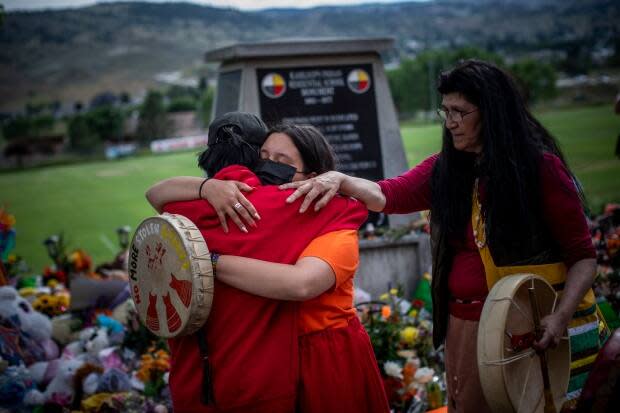First Nation to release findings on discovery of remains at site of former residential school

WARNING: This story contains details some readers may find distressing.
Nearly two months after the Tk'emlúps te Secwépemc First Nation sparked a national reckoning — when it announced it had discovered the buried remains of an estimated 215 children on the grounds of a former residential school — its leaders say they will release their detailed report on the findings on Thursday.
The First Nation, near Kamloops, B.C., announced it will publicly unveil the results from its ground-penetrating radar scans, which have since inspired many other Indigenous communities to seek out the technology themselves, and have renewed long-standing calls for justice.
WATCH | Residential school survivor recites poem for deceased children:
The release being planned this week will include a "briefing on the ground-penetrating radar work undertaken," as well as "next steps" for the First Nation. It will also include statements from survivors of the institution.
The Kamloops Indian Residential School, run by a Catholic order, was once the largest such institution in Canada.
Soon after the Tk'emlúps te Secwépemc ground-penetrating radar findings, Cowessess First Nation in Saskatchewan revealed it had found 751 unmarked graves on the site of the Marieval Indian Residential School, the last such Canadian institution to close in 1997. Other communities have since confirmed their own such tragic findings.
More than 150,000 Indigenous children were forced to attend the institutions from the 1870s until the late 1990s, and many were abused physically and sexually, forced to learn English and violently prevented from practising their cultural traditions and languages.
WATCH | Residential school survivors on the scars of abuse:
In 2015, the Truth and Reconciliation Commission released its report after cross-country hearings that heard months of testimony.
The commission concluded that at least 4,100 of the Indigenous children forced to attend the church-run institutions died but that half of the deaths had no recorded cause; one-third of the deaths were recorded without even a name. Indigenous experts say the number is likely much higher.
Tk'emlúps te Secwépemc said it will host a public live stream and event to release the full findings — titled "KIRS Le Estcwéý (The Missing)" — on Thursday at 9 a.m. on its website.
Support is available for anyone affected by the lingering effects of residential schools and those who are triggered by the latest reports. The Indian Residential School Survivors Society can be contacted toll-free at 1-800-721-0066.
A national Indian Residential School Crisis Line has been set up to provide support for former students and those affected. Access emotional and crisis referral services by calling the 24-hour national crisis line: 1-866-925-4419.
Within B.C., the KUU-US Crisis Line Society provides a First Nations and Indigenous-specific crisis line available 24 hours a day, seven days a week. It's toll free and can be reached at 1-800-588-8717 or online at kuu-uscrisisline.com.

